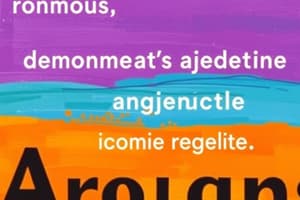Podcast
Questions and Answers
Participles end in -ed, -d, -t, -en, or -n.
Participles end in -ed, -d, -t, -en, or -n.
True (A)
Gerunds function as adjectives in a sentence.
Gerunds function as adjectives in a sentence.
False (B)
Infinitives are always followed by a verb in base form.
Infinitives are always followed by a verb in base form.
True (A)
Prefixes are added to the end of root words to alter their meaning.
Prefixes are added to the end of root words to alter their meaning.
Commas are used after conjunctions to separate independent clauses.
Commas are used after conjunctions to separate independent clauses.
Suffixes do not change the word type when added to root words.
Suffixes do not change the word type when added to root words.
A root word cannot stand alone.
A root word cannot stand alone.
Demonstrative pronouns need to be placed close to the noun or noun phrase they reference.
Demonstrative pronouns need to be placed close to the noun or noun phrase they reference.
Relative pronouns can sometimes stand alone within a sentence structure.
Relative pronouns can sometimes stand alone within a sentence structure.
The words this and that function only as singular demonstrative pronouns.
The words this and that function only as singular demonstrative pronouns.
Relative pronouns are essential for forming relative clauses by connecting to an adjective clause.
Relative pronouns are essential for forming relative clauses by connecting to an adjective clause.
Demonstrative adjectives differ from demonstrative pronouns based on their position in relation to nouns.
Demonstrative adjectives differ from demonstrative pronouns based on their position in relation to nouns.
The zero relative pronoun can be used as the subject of a sentence.
The zero relative pronoun can be used as the subject of a sentence.
Adjectives that follow the demonstrative words this, that, these, and those are called demonstrative adjectives.
Adjectives that follow the demonstrative words this, that, these, and those are called demonstrative adjectives.
Whoever and whomever are never considered relative pronouns.
Whoever and whomever are never considered relative pronouns.
Flashcards
Pronoun
Pronoun
A word that takes the place of a noun or noun phrase, such as "he", "she", "it", "they", "we", or "you".
Demonstrative Pronoun
Demonstrative Pronoun
Pronouns that point to specific nouns or noun phrases, like "this", "that", "these", and "those".
Demonstrative Adjective
Demonstrative Adjective
Demonstrative pronouns used to describe a specific noun or pronoun.
Relative Pronoun
Relative Pronoun
Signup and view all the flashcards
Adjective Clause
Adjective Clause
Signup and view all the flashcards
Relative Pronoun List
Relative Pronoun List
Signup and view all the flashcards
Zero Relative Pronoun
Zero Relative Pronoun
Signup and view all the flashcards
Interrogative Relative Clause
Interrogative Relative Clause
Signup and view all the flashcards
What are verbals?
What are verbals?
Signup and view all the flashcards
What is a gerund?
What is a gerund?
Signup and view all the flashcards
What is a participle?
What is a participle?
Signup and view all the flashcards
What is an infinitive?
What is an infinitive?
Signup and view all the flashcards
What is a root word?
What is a root word?
Signup and view all the flashcards
What are prefixes?
What are prefixes?
Signup and view all the flashcards
What are suffixes?
What are suffixes?
Signup and view all the flashcards
Study Notes
Pronouns and Demonstrative Pronouns
- Pronouns replace nouns or noun phrases.
- Demonstrative pronouns (this, that, these, those) point to specific nouns, noun phrases, or clauses.
- Demonstrative pronouns should be close to the nouns they refer to.
- Demonstrative pronouns can be singular (this, that) or plural (these, those).
Adjectives and Demonstrative Adjectives
- Adjectives describe or modify nouns or pronouns.
- Demonstrative adjectives also specify nouns or pronouns.
- Demonstrative adjectives are used before nouns (e.g., this book).
- Demonstrative pronouns are used as substitutes for nouns like this apple
Relative Pronouns
- Relative pronouns connect a noun/pronoun to an adjective clause (a clause that modifies another part of the sentence).
- The common relative pronouns are who, whom, whose, which, and that. Whoever, whomever are also considered relative pronouns sometimes.
- Relative pronouns are rarely used alone.
- In some cases, the relative pronoun may be omitted. This is called a zero-relative pronoun.
Verbals
- Verbals are verbs that function as nouns, adjectives, or adverbs.
- Three types of verbals are gerunds, participles, and infinitives.
- Gerunds (end in -ing) function as nouns (e.g., reading is fun).
- Participles function as adjectives. There are present (end in -ing) and past participles (end in -ed, -d, -t, -en, or -n).
- Infinitives (to + verb base form) function as nouns, adjectives, or adverbs (e.g., to sleep, to be happy, to walk quickly).
Root Words, Prefixes, and Suffixes
- Root words (or base words) are the core parts of words that cannot be broken down further.
- Prefixes are added before root words.
- Suffixes are added after root words.
Suffixes
- Suffixes are added to words to modify their meaning or create different word types (e.g., nouns to verbs).
- Rules for adding a suffix depend on the base word's ending (silent "e," vowel sound, syllables).
Commas
- Commas indicate pauses, mark items in lists, enclose nonessential clauses or phrases, separate appositives, indicate direct address, show quotations in dialogue, separate towns and states, and yearly dates
- Commas are used with coordinating conjunctions, introductory clauses.
Studying That Suits You
Use AI to generate personalized quizzes and flashcards to suit your learning preferences.




